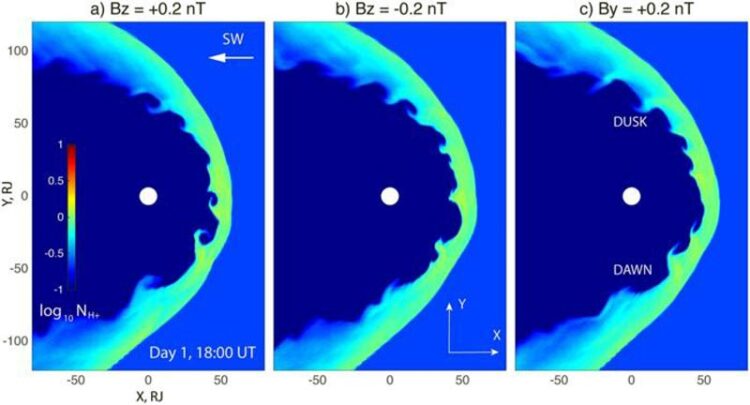Giant swirling waves at the edge of Jupiter’s magnetosphere

An SwRI-led team identified intermittent evidence of Kelvin-Helmholtz instabilities, giant swirling waves, at the boundary between Jupiter’s magnetosphere and the solar wind that fills interplanetary space, modeled here by University Corporation for Atmospheric Research scientists in a 2017 GRL paper.
Credit: UCAR/Zhang, et.al.
Waves produced by Kelvin-Helmholtz instabilities transfer energy in the solar system.
A team led by Southwest Research Institute (SwRI) and The University of Texas at San Antonio (UTSA) has found that NASA’s Juno spacecraft orbiting Jupiter frequently encounters giant swirling waves at the boundary between the solar wind and Jupiter’s magnetosphere. The waves are an important process for transferring energy and mass from the solar wind, a stream of charged particles emitted by the Sun, to planetary space environments.
Jake Montgomery, a doctoral student in the joint space physics program between UTSA and SwRI, noted that these phenomena occur when a large difference in velocity forms across the boundary between two regions in space. This can create a swirling wave, or vortex, at the interface that separates a planet’s magnetic field and the solar wind, known as the magnetopause. These Kelvin-Helmholtz waves are not visible to the naked eye but can be detected through instrument observations of plasma and magnetic fields in space. Plasma — a fundamental state of matter made up of charged particles, ions and electrons — is ubiquitous across the universe.
“Kelvin-Helmholtz instabilities are a fundamental physical process that occurs when solar and stellar winds interact with planetary magnetic fields across our solar system and throughout the universe,” Montgomery said. “Juno observed these waves during many of its orbits, providing conclusive evidence that Kelvin-Helmholtz instabilities play an active role in the interaction between the solar wind and Jupiter.”
Montgomery is the lead author of a study published in Geophysical Research Letters that uses data from multiple Juno instruments, including its magnetometer and the SwRI-built Jovian Auroral Distributions Experiment (JADE).
“Juno’s extensive time near Jupiter’s magnetopause has enabled detailed observations of phenomena such as Kelvin-Helmholtz instabilities in this region,” said Dr. Robert Ebert, a staff scientist at SwRI who also serves as an adjoint professor at UTSA. “This solar wind interaction is important as it can transport plasma and energy across the magnetopause, into Jupiter’s magnetosphere, driving activity within that system.”
The paper “Investigating the Occurrence of Kelvin-Helmholtz Instabilities at Jupiter’s Dawn Magnetopause” appears in Geophysical Research Letters and can be accessed at https://doi.org/10.1029/2023GL102921.
For more information, visit https://www.swri.org/planetary-science.
Journal: Geophysical Research Letters
DOI: 10.1029/2023GL102921
Method of Research: Observational study
Subject of Research: Not applicable
Media Contacts
Cecilia Novak
Southwest Research Institute
cecilia.novak@swri.org
Deb Schmid
Southwest Research Institute
dschmid@swri.org
Office: 210-522-2254
All latest news from the category: Physics and Astronomy
This area deals with the fundamental laws and building blocks of nature and how they interact, the properties and the behavior of matter, and research into space and time and their structures.
innovations-report provides in-depth reports and articles on subjects such as astrophysics, laser technologies, nuclear, quantum, particle and solid-state physics, nanotechnologies, planetary research and findings (Mars, Venus) and developments related to the Hubble Telescope.
Newest articles

NASA: Mystery of life’s handedness deepens
The mystery of why life uses molecules with specific orientations has deepened with a NASA-funded discovery that RNA — a key molecule thought to have potentially held the instructions for…

What are the effects of historic lithium mining on water quality?
Study reveals low levels of common contaminants but high levels of other elements in waters associated with an abandoned lithium mine. Lithium ore and mining waste from a historic lithium…

Quantum-inspired design boosts efficiency of heat-to-electricity conversion
Rice engineers take unconventional route to improving thermophotovoltaic systems. Researchers at Rice University have found a new way to improve a key element of thermophotovoltaic (TPV) systems, which convert heat…



